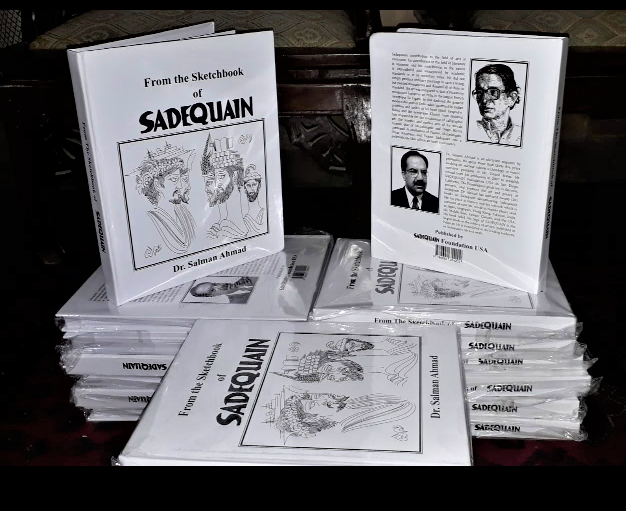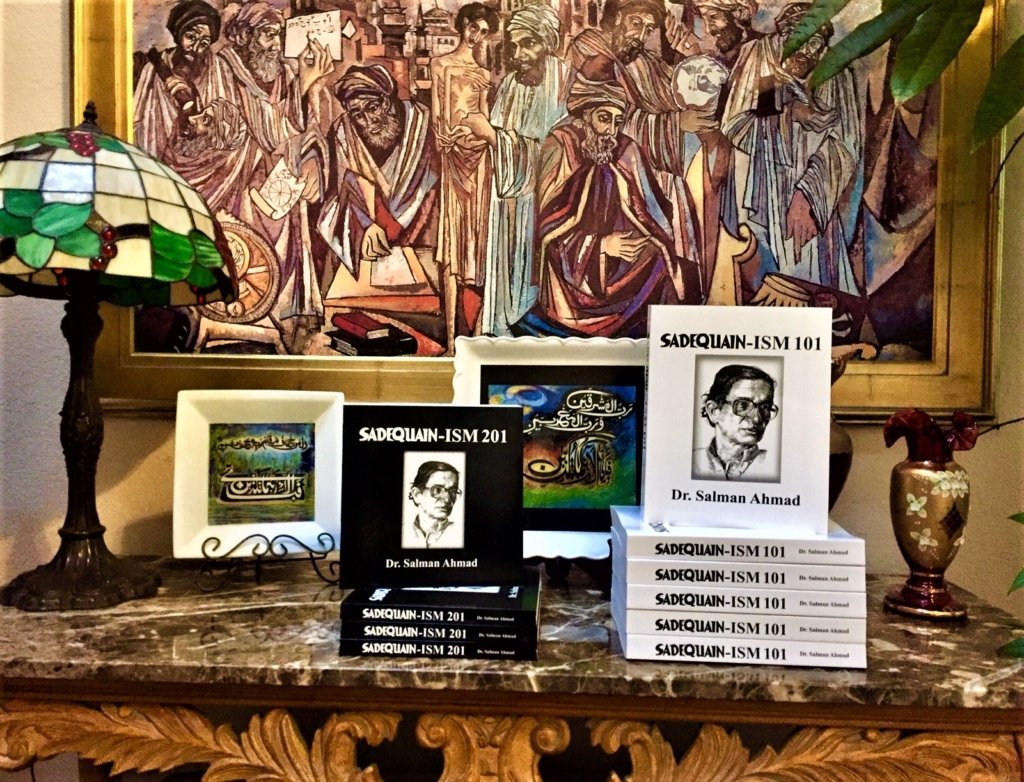The California-based Sadequain Foundation has published the 25th book on the 34th anniversary of the legendary artist, poet and intellectual.
By Farman Ali

Islamabad: A new book of drawings by Sadequain, an internationally-acclaimed and Pakistan’s most revered calligrapher, muralist, poet, intellectual has been published.
The book is the latest link in the chain of continuing efforts by the Sadequain Foundation published to commemorate the 34th anniversary of the iconic artist.
“The Foundation has done an exhaustive search for the scattered artworks of Sadequain which he carelessly gave away as soon as he made them, leaving no trace and no catalogue to preserve his legacy,” says Dr Salman Ahmad, the founder of the San Diego-based Foundation.
The drawings in the new book, according to Dr Ahmad, demonstrate Sadequain’s masterful skill as an artist, flight of his imagination, and depth of his intellect as he addressed delicate and tantalizing subjects.
“Sadequain stroked new life into the centuries-old art of Islamic calligraphy, turning words into vibrantly detailed expressionist paintings,” Google reminds us.
The drawings display the unity of the disciplines, calligraphy, and the traditions of Urdu and Persian poetry which Sadequain shared to his core. Most importantly, the drawings show how Sadequain’s lines, whether complex or simple, performed magically with the complexity of a well-orchestrated symphony; they represent poetry of colour, the harmony of rhythm, and the power of a tempest, he said.
The second edition has been printed in Pakistan this month. The first edition was published by Amazon in the USA in 2020.
The book will be helpful in analyzing the imagery in Sadequain’s drawings and establishing the links to appropriate historical and cultural context. Its empirical research and textual contents are balanced to address the sensitivities that attempt to compare and contrast arbitrary and loaded concepts.

Sadequain (1930–1987), was a household name when alive. The government of Pakistan established three art galleries in his name in Karachi, Lahore, and Islamabad.
However, after he died all the three galleries were closed and the artworks amounting to over $100 million went unaccounted for. By the year 2006 his name had been wiped out from the collective memory of the nation. One of a handful of Pakistanis whose name and work should transcend centuries, Sadequain had been forgotten.
It’s worth mentioning here that Sadequain was recognized and praised by the world media in his lifetime. Not many Pakistanis can make this claim. French newspaper Le Monde quoted “Sadequain’s multiplicity is reminiscent of Picasso.” UAE newspaper Khaleej Times declared him responsible for the “renaissance of calligraphic art.”
Dr Ahmad regretted that Sadequain’s home ‘Sibtain Manzil’, which should have been converted into a museum in his name, was grabbed, illegally sold, and all proceeds were embezzled.
The most egregious of all the injustices was the grabbing of a large piece of land in a prominent location in Karachi that was allotted to Sadequain by the Karachi Development Authority (KDA) for the sole purpose of establishing an art institute in Sadequain’s name.
His contribution to the country is unsurpassed in academic and monetary terms, but the nation did not accord him the reverence he deserved.
However, Dr Salman Ahmad has done some commendable work to keep Sadequain completely fading out from our collective memory.
The Foundation has resurrected the legendary artist from oblivion by publishing 25 books on Sadequain’s life, work, place in history, and his artwork which is scattered around the world in remote places such as Japan, Singapore, Hong Kong, Pakistan, India, the Middle East, Europe, Canada, and the USA.
The Foundation has also arranged more than 100 seminars and exhibitions in universities and museums around the world. It established Galerie Sadequain in 2017 in historic Frere Hall in Karachi.
Sadequain for his intellect and what he gave to the nation has no parallel. His contribution to the field of arts and literature is unparalleled and unsurpassed by academic standards or in its monetary value, Dr Salman Ahmad said.
He did not simply produce ordinary paintings to earn a living, but painted monuments and donated all of them to mankind.
His art was compared to that of Picasso by European art critics in major newspapers and declared him the greatest modern-day poet of Urdu rubai (quatrain) responsible for the renaissance of calligraphic art.
The number and surface area of his murals exceeds that of Michelangelo and Diego Rivera combined, the author wrote.
“A confluence of Picasso, Michelangelo, Omar Khayyam, and Yaqoot, Sadequain was a polymath, the likes of him are born in centuries.”
Sadequain never sold his work except for a very few large commissioned works. He simply gave away his work and hence was his own worst enemy. There were no records, no inventory etc.
Sadequain Foundation
It was in June 2007 when Dr Salman Ahmad, an electrical engineer by profession, founded the Sadequain Foundation in California, to discover, preserve, catalogue, and promote the intellectual artist’s work and introduce it to the world. The Foundation did an exhaustive search to locate thousands of Sadequain’s artworks in places as far as Singapore, Hong Kong, India, Middle East, Austria, Switzerland, France, England, the USA, and Canada.
Dr Ahmad has authored 25 books on Sadequain including ‘Sadequain-ism 201’, ‘The Legend of Sadequain – Renaissance of Calligraphic Art’, ‘Sadequain: Strokes of Picasso — Scale of Michelangelo’, ‘Mystic Expressions by Sadequain – An Odyssey to Exaltation with Ghalib, Iqbal, Faiz’, and Sadequain’, ‘Realism to Calligraphic Cubism – The Legacy of Sadequain from Paris to Pakistan’, ‘Ghalib and Sadequain’ (in Hindi), ‘Trails of the Lost Art of Sadequain’, and ‘The Saga of Sadequain,’ the largest book on the subject of art ever published in Pakistan.
The book titled Sadequainism 201, has been published by the Santiago-based Sadequain Foundation. “The primary focus of this book is to sum-up Sadequain’s perceptions, in which he draws inspiration from the ancient wisdom of Sufi traditions, which for centuries have represented some of mankind’s purest instincts,” says Dr Ahmad.

As archetypal expressions of mystic vision, his philosophy transcends our latent susceptibilities. They hold a beacon to the path of enlightenment, guide through the gateway of spiritual freedom, and provide a conduit to transpersonal truth.
The 350-page book takes the reader on a blissful odyssey; an unadulterated experience of heightened awareness, as the senses process the concepts and nurture the experiences for a meaningful life. Sadequain’s approach reflects various states of self-realization and consciousness. He reaches down and attains awareness of the innermost sentiments as they manifest themselves in rapturous passion.
“There are many more books and related projects in the pipeline” says Dr Ahmad.
Sadequain’s paintings at MET
The iconic painting by Sadequain, Seascape Three Boats are on display at the New York Metropolitan Museum (The MET), one of the largest museums of art in the world.
To paying homage to one of the greatest artists of the recent time, the MET displayed an iconic painting by Sadequain in its main gallery.
